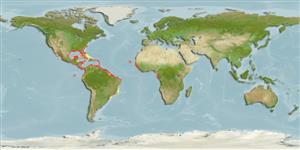Environment: milieu / climate zone / depth range / distribution range
Ökologie
seewasser; brackwasser riff-verbunden; tiefenbereich 0 - 100 m (Ref. 9710), usually ? - 46 m (Ref. 55295). Subtropical; 36°N - 33°S, 121°W - 12°E (Ref. 55295)
Western Atlantic: Florida, USA to southern Brazil, including the Gulf of Mexico and the Caribbean. Eastern Atlantic: Senegal to Congo (reported as Epinephelus esonue, Ref. 2739, 6809); rare in Canary Islands (Ref. 6808). Eastern Pacific (Gulf of California to Peru) species refers to Epinephelus quinquefasciatus. Discrete populations of E. itajara exist in the western Atlantic (Ref. 89627).
Length at first maturity / Size / Gewicht / Alter
Maturity: Lm 128.0 range ? - ? cm
Max length : 250 cm TL Männchen/unbestimmt; (Ref. 26550); common length : 150 cm TL Männchen/unbestimmt; (Ref. 5217); max. veröff. Gewicht: 455.0 kg (Ref. 4841); max. veröff. Alter: 37 Jahre (Ref. 4841)
Rückenflossenstacheln (insgesamt): 11; Rückenflossenweichstrahlen (insgesamt): 15-16; Afterflossenstacheln 3; Afterflossenweichstrahlen: 8. Distinguished by the following characteristics: brownish yellow, grey or greenish body color; head and dorsal part of body and fins with small black spots; body robust and elongate; body depth contained 2.7-3.4 times in SL; HL 2.3-2.9 in SL; extremely broad head; flat interorbital; rounded preopercle, finely serrate; round nostrils, subequal; maxilla scaly, reaching well past eye; 3-5 rows of subequal teeth on midlateral part of lower jaw; absence of canines at front jaw (Ref. 89707); further characterized by having opercle with 3 flat spines, middle one the largest. Pelvic fins smaller than the pectorals. Bases of soft dorsal and anal fins covered with scales and thick skin. Juveniles tawny with irregular vertical bands.
A solitary species (Ref. 26340) occurring in shallow, inshore areas. Found on rock, coral, or mud bottoms (Ref. 5217). Juveniles found in mangrove areas and brackish estuaries (Ref. 5217). Large adults may be found in estuaries (Ref. 5217). Adults appear to occupy limited home ranges with little inter-reef movement. Feeds primarily on crustaceans, particularly spiny lobsters as well as turtles and fishes, including stingrays. Territorial near its refuge cave or wreck where it may show a threat display with open mouth and quivering body. Larger individuals have been known to stalk and attacks divers. Over-fished, primarily by spear fishing (Ref. 9710). Marketed fresh and salted. Meat is of excellent quality. Important game fish (Ref. 9342). Reported to reach weights of more than 315 kg (Ref. 26938).
Heemstra, P.C. and J.E. Randall, 1993. FAO Species Catalogue. Vol. 16. Groupers of the world (family Serranidae, subfamily Epinephelinae). An annotated and illustrated catalogue of the grouper, rockcod, hind, coral grouper and lyretail species known to date. Rome: FAO. FAO Fish. Synop. 125(16):382 p. (Ref. 5222)
IUCN Rote Liste Status (Ref. 130435)
Bedrohung für Menschen
Traumatogenic (Ref. 4716)
Nutzung durch Menschen
Fischereien: weniger kommerziell; Sportfisch: ja
Tools
Zusatzinformationen
Download XML
Internet Quellen
Estimates based on models
Preferred temperature (Ref.
123201): 22.8 - 28, mean 26.3 °C (based on 532 cells).
Phylogenetic diversity index (Ref.
82804): PD
50 = 0.5000 [Uniqueness, from 0.5 = low to 2.0 = high].
Bayesian length-weight: a=0.01096 (0.00641 - 0.01876), b=3.03 (2.89 - 3.17), in cm total length, based on LWR estimates for this species & Genus-body shape (Ref.
93245).
Trophic level (Ref.
69278): 4.1 ±0.0 se; based on diet studies.
Generation time: 8.7 ( na - na) years. Estimated as median ln(3)/K based on 1
growth studies.
Widerstandsfähigkeit (Ref.
120179): niedrig, Verdopplung der Population dauert 4,5 - 14 Jahre. (K=0.13; tm=5.5-6.5).
Fishing Vulnerability (Ref.
59153): High to very high vulnerability (70 of 100).
Nutrients (Ref.
124155): Calcium = 7.75 [2.67, 16.99] mg/100g; Iron = 0.365 [0.171, 0.783] mg/100g; Protein = 19.9 [18.3, 21.5] %; Omega3 = 0.169 [0.084, 0.334] g/100g; Selenium = 25.9 [11.7, 60.3] μg/100g; VitaminA = 40.7 [8.5, 195.4] μg/100g; Zinc = 0.626 [0.390, 0.977] mg/100g (wet weight);
